#countess potocka
Explore tagged Tumblr posts
Text

"To return to the ball. It was one of the most remarkable that it was ever my privilege to attend. The emperor took part in a square dance, which paved the way for his affair with Madame Walewska.
"How do you think I dance?" he asked me, smiling. "I suspect you have been laughing at me."
" In truth, sire," I replied, "for a great man your dancing is perfect."
A little before that Napoleon had seated himself between the future favourite and myself. After talking for a few minutes he asked me who his other neighbour was. As soon as I had mentioned her name, he turned to her as if no one knew more about her than he.
We learnt afterward that M. de Talleyrand had extended his labours as far as managing this first interview and smoothing the preliminary obstacles. Napoleon, having expressed a wish to count a Pole among his conquests, one of the right kind was chosen — lovely and dull. Some pretended to have noticed that, after the quadrille, the emperor had shaken hands with her, which was equivalent, they said, to an appointment; and it did take place, in fact, the next evening. It was rumoured that a great dignitary had gone to fetch the fair one ; quick and undeserved promotion for a good-for-nothing brother was spoken of, and a diamond ornament, which was said to have been refused. People said a great many things they perhaps did not know and invented at pleasure. They even went so far as to assert that Rustan, the Mameluke, had acted as lady's maid ! What is certain, however, is that we were all distressed that a person admitted to society had shown such facility, and had defended herself as little as the fortress of Ulm.
But time, which colours everything, gave this connection, so lightly contracted, a tinge of constancy and disinterestedness which partly effaced the irregularity of its origin, and ended in placing Madame Walewska among the notable personages of her period. Exquisitely pretty, she was a realization of Greuze's faces; her eyes, her mouth, and her teeth were beautiful. Her laugh was so fresh, her gaze so soft, her face so seductive, as a whole, that it was never apparent that anything was wanting to the complete regularity of her features".
Memoirs of the Countess Potocka
24 notes
·
View notes
Text
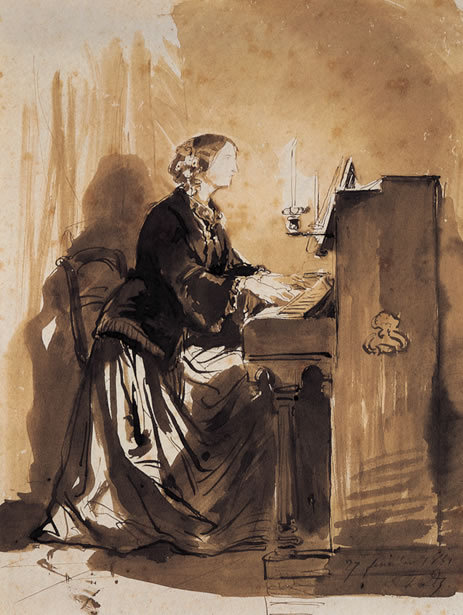
Title: Countess Potocka Playing Piano
Artist: Paul Delaroche
Date: 1851
Style: Romanticism
Genre: Genre Painting
#art history#art#painting#artwork#museums#history#culture#vintage#curators#romanticism#paul delaroche#classicalcanvas
126 notes
·
View notes
Text

Death of Chopin
Date: Félix-Joseph Barrias (French, 1822–1907)
Date: 1885
Medium: Oil on canvas
Collection: The National Museum in Krakow, Poland
Description
The French artist Felix-Joseph Barrias, since he painted this work 46 years after the composer's death, may have used an account of Chopin's dying moments that was conveyed to posterity by Solange, George Sand's daughter and the sculptor Clésinger's wife: "One October afternoon in 1849, on the 16th, around twenty people were apprehensively waiting in the drawing room […]. Chopin wanted to know whether Countess Potocka was also in the drawing room and if she would like to sing closer, the door was wide open, and the beautiful countess started to sing. She was singing with her heart broken, with a voice full of tears! The people in the room dropped to their knees, choking back their sobs.”
The refined lady in white, standing by the piano, is probably Countess Delfina Potocka, who, according to tradition, sang the song "Pieta Signore" (Have Mercy Upon Me), which at the time was attributed to Alessandro Stradelli and is now attributed to the 19th-century composer Niedermayer. At one side of the bed, on the left next to a nun, Solange herself is kneeling; at the other side of the bed, Chopin's sister Ludwika is holding the dying composer's hand; in the foreground to the right, Marcelina Czartoryska, Chopin's pupil, and further at the window, Father Aleksander Jełowiecki, the painter Teofil Kwiatkowski (he left a series of beautiful pencil and watercolor sketches representing Chopin both at the piano and on his death bed) and Wojciech Grzymała.
Two Swedish researchers, Cecilia and Jens Jorgensen, argue that Barrias created the painting in collaboration with his pupil, Countess Winnaretta de Polignac (1865–1943), Edmond de Polignac's widow and a philanthropist and patron of artists and scientists. She was the daughter of Isaac Singer, the inventor of the sewing machine. Reportedly, he wanted to name the first model of the sewing machine he constructed after Jenny Lind (1820–1887), an eminent Swedish soprano singer and, since Hans Christian Andersen dedicated one of his fairy-tales to her, also known as the Swedish nightingale. She met Chopin in 1848 in London during one of his last tours in the city and was intending to marry the composer.
Two weeks after the artist's death, she arranged and paid for an extremely ceremonious funeral, which started with a mass held at l'Église Sainte-Marie-Madeleine, during which she sang arias from Bellini's opera. In 1851, she met Countess Winnaretta de Polignac, and it is possible that they made a decision together to commission a painting that represents Chopin in his dying moments. We know a little about how the work was created, but we know that it was the property of Countess Winnaretta, and later Count Campofelice. According to the Jorgensens, the woman that the painting represents in white while standing at the piano is not Delfina Potocka, but Jenny Lind.
#death bed#oil painting#europe#france#paris#chopin#classical composer#piano#men#women#felix joseph barrias#french painter#19th century painting#inside#mood#atmosphere#history
8 notes
·
View notes
Text
IN THE FARTHEST BORDERLANDS OF THE TIME OF THE FIRST POLISH-LITHUANIAN COMMONWEALTH: THE RACEVO ESTATE AND THE ZAMOYSKY COUNT'S FAMILY // PART 2
Ignatiy Menzhinsky was married (since 1875) to Olympia (Olympiad) Tyundevitskaya (1841-1920), daughter of Melchior Tyundevitsky and Camilla Bogdanovich, sister of Mikhail Tyundevitsky from Goloshevo (now a village in Tolochinsky district of Vitebsk region). They had two daughters: Anna (1876-1959) and Maria (1976/1978-1956).
Anna Menzhinskaya, who became the wife of Leon Zholtovsky, had a daughter, Countess Maria Zholtovskaya (09.06.1906 – 07.08.1999). Konstantin Nikolai Jozef Radziwill (10.08.1902 – September 1944), a Polish aristocrat and landowner, an officer of the Home Army, married her on 08/24/1927. He was a representative of the princely Radziwill family of the «Pipes» coat of arms. He was killed during the Warsaw Uprising.
II. ZAMOYSKIYE In 1900, in Krakow, Maria, nee Menzhinskaya coat of arms «Koscesa», married Count Vladislav-Zhdislav (Zdislav) Zamoyski (19.12.1873 – 07.12.1944), a native of Vysotsk near Yaroslavl in Subcarpathia, a representative of the coat of arms «Elita». It was he who later inherited the Racevo estate.

Vladislav-Zdislav's father, Stefan Zamoyski (1857-1899), was a Polish count and landowner:
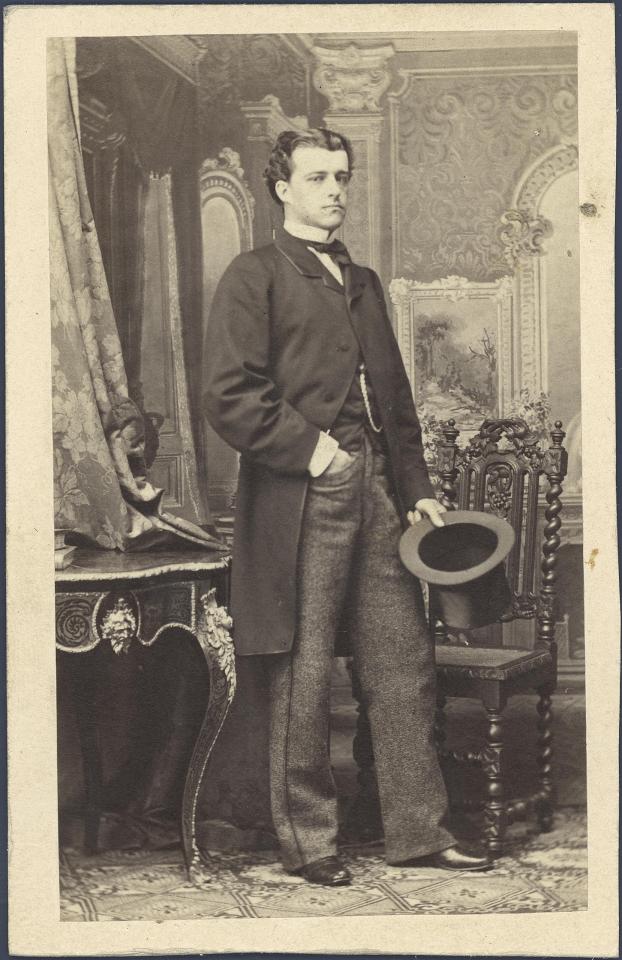
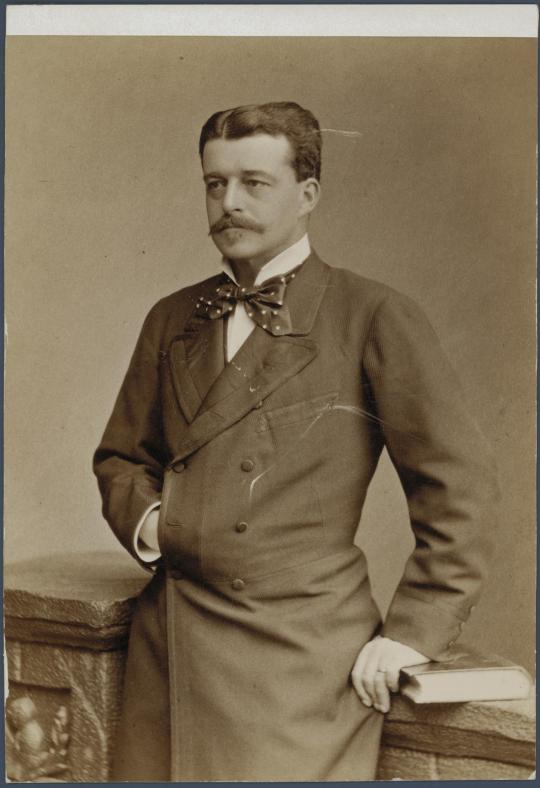
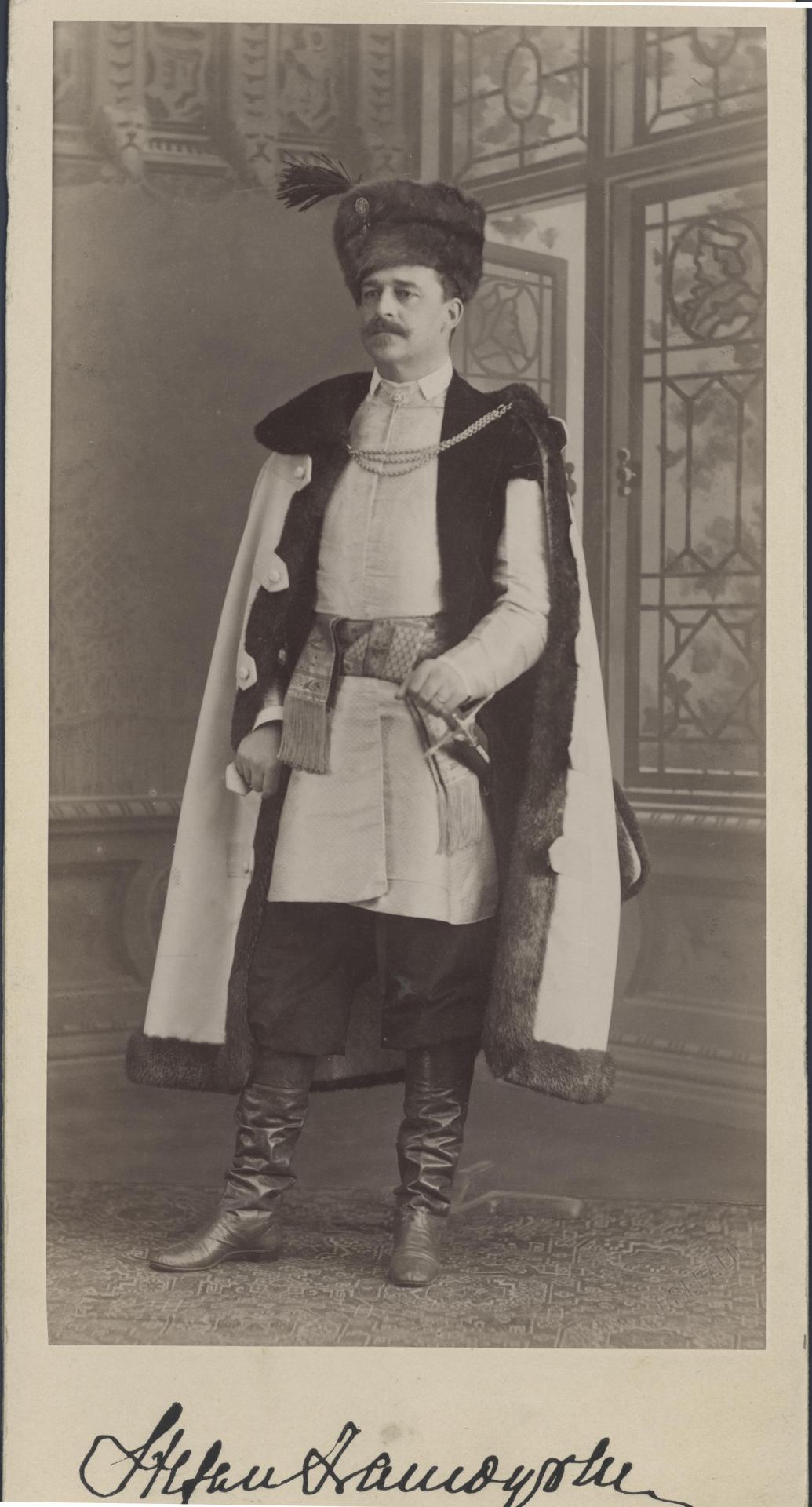
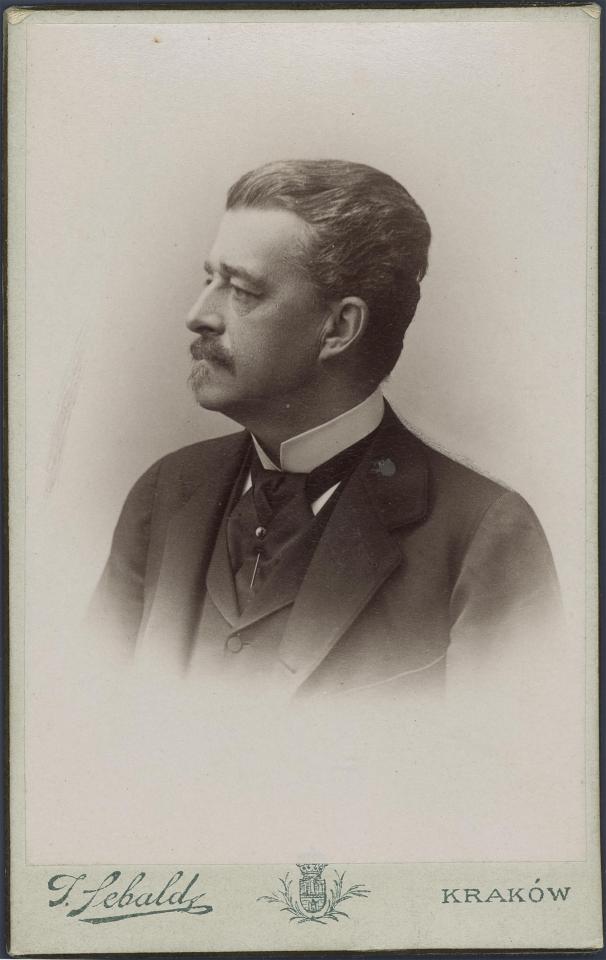

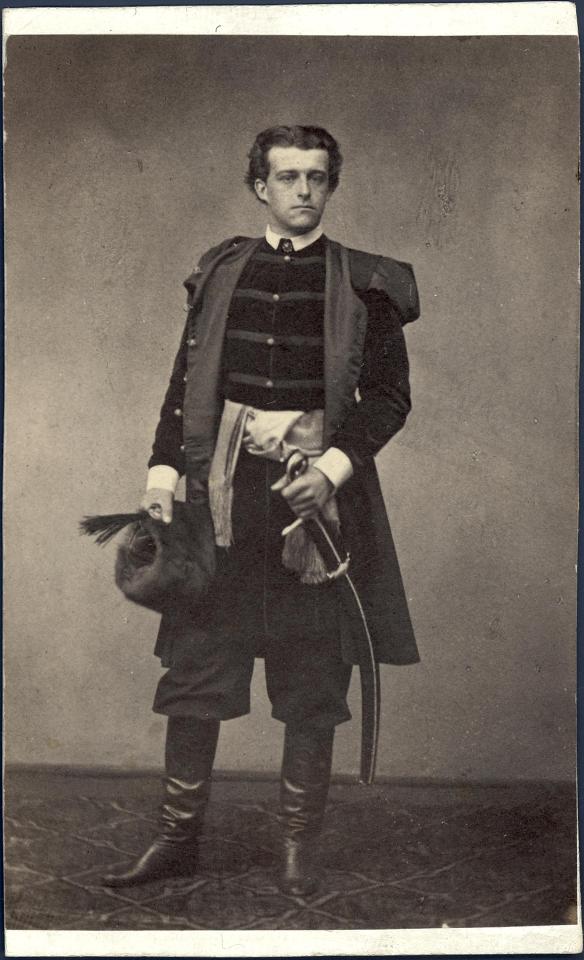
And his mother, Sofya Adamovna Potocka (1851-1927), belonged to the wealthy Polish nobility:






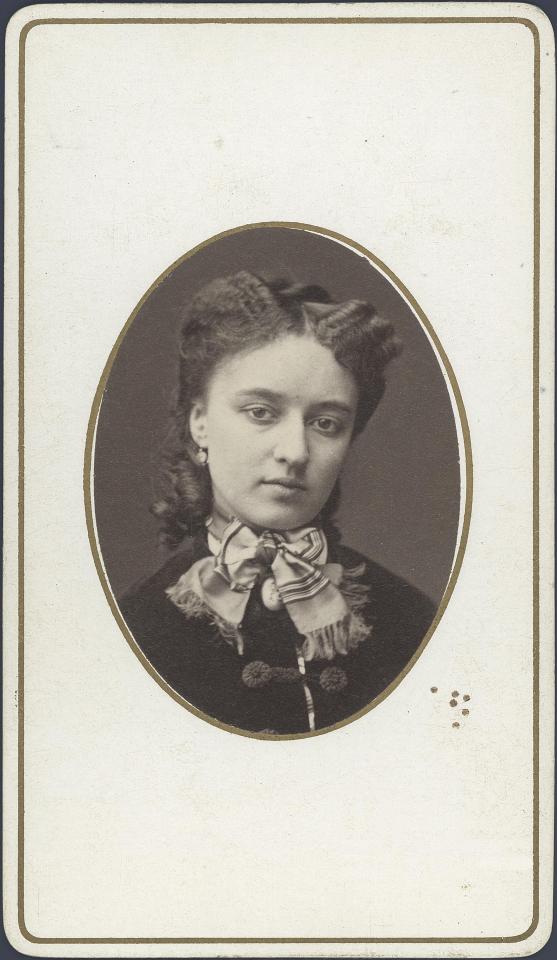




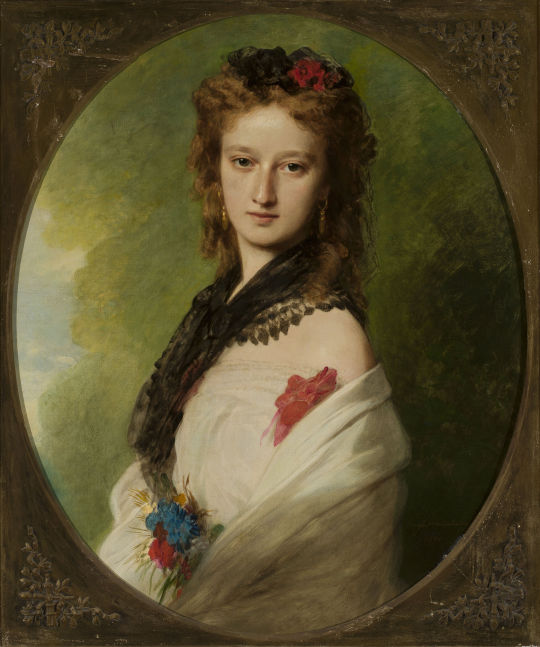
Vladislav Zamoyski was one of six children in the family.
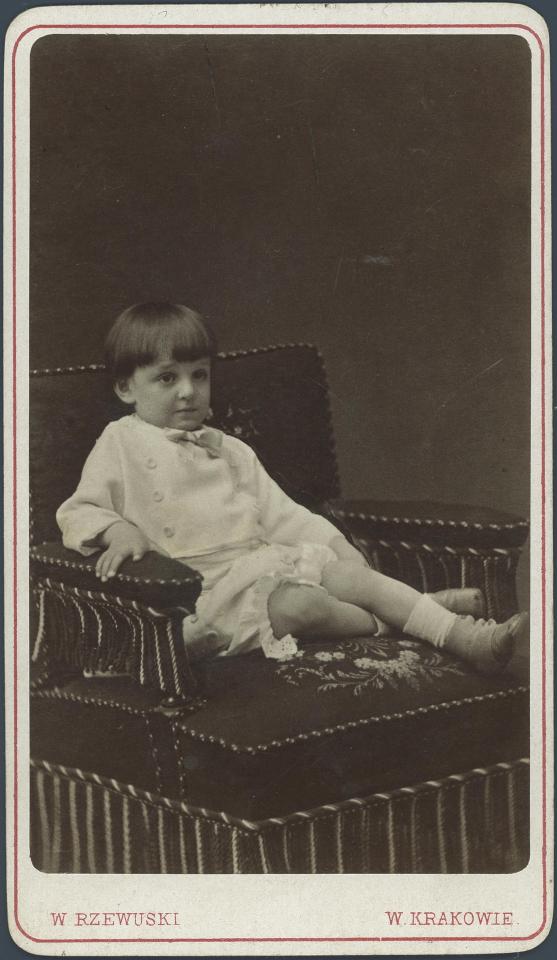

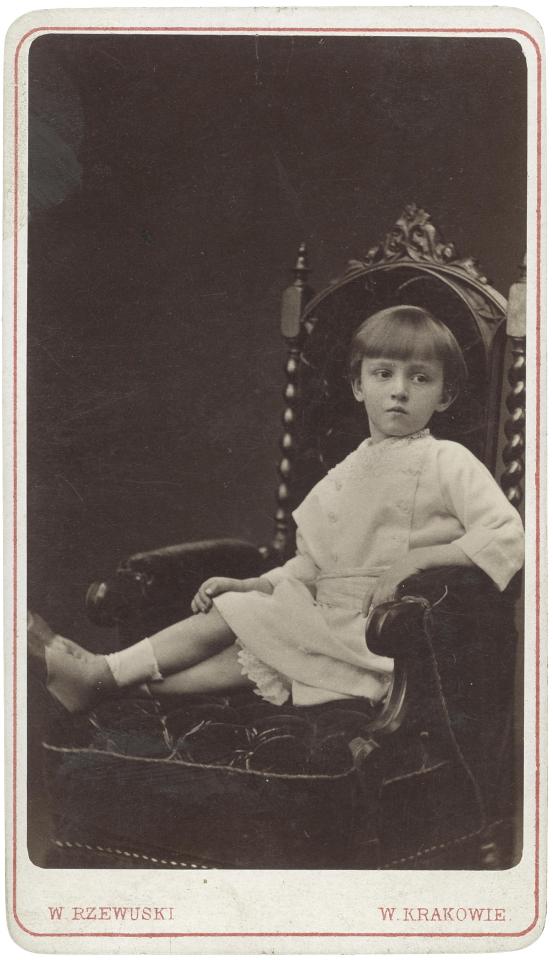

#history#belarus#old history#polish#poland history#belarusian history#historical#historic#old photos#aristocratic#aristocracy#poland aristocracy#belarusian village#aesthetic of villages#village history#belarusian aesthetic#village#rural#rural life#rural aesthetic#aesthetic#photography
2 notes
·
View notes
Text
Józef Poniatowski’s women.
Part V. The rest of ladies who might have been of some interest to him
Good day everyone and let me share with the rest of information I possess on Prince Poniatowski's love interests. (Though, I have to admit, the ladies from this list were the least likely - from all the mentioned in these series of post - to have some kind of affair with Pepi.
To start I would like by Louise of Mecklenburg-Strelitz, the queen of Prussia.
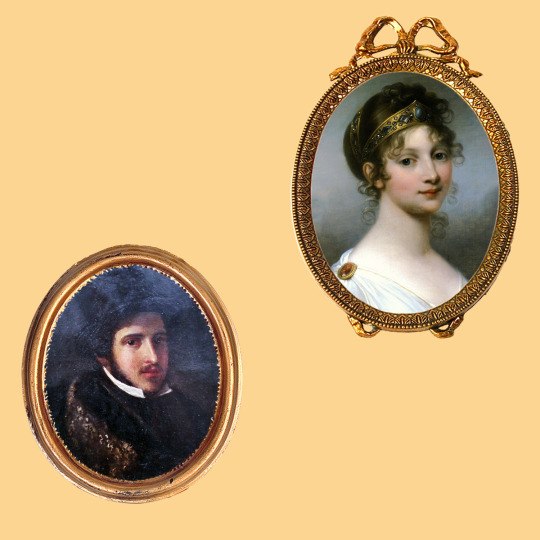
On the right - unidentified artist, miniature portrait of Prince Poniatowski, 19th century. On the left - portrait of Queen Louise by Giuseppe Grassi, 1802.
Prince Józef had the opportunity to meet the wife of the king Frederick William III at least four times, because the royal couple visited Warsaw - which had become a part of Prussia as a result of the third partition of Poland - three times, in 1798, 1802 and 1805. And in 1802 Poniatowski himself had to go to Berlin, to settle the matter of the inheritance left by his uncle Stanisław August.
According to Juliusz Fałkowski, while at Warsaw Prince Józef "…gave a ball and a dinner in the Copper-Roof palace in their honor [the King and Queen of Prussia - A.S.] and was flirting with the Queen everywhere", for which he received the star of the black eagle, although he rather "expected something else from the beautiful queen." After the departure of the royal couple, "he longed a little for the crowned beauty who had easily won his heart in passing."
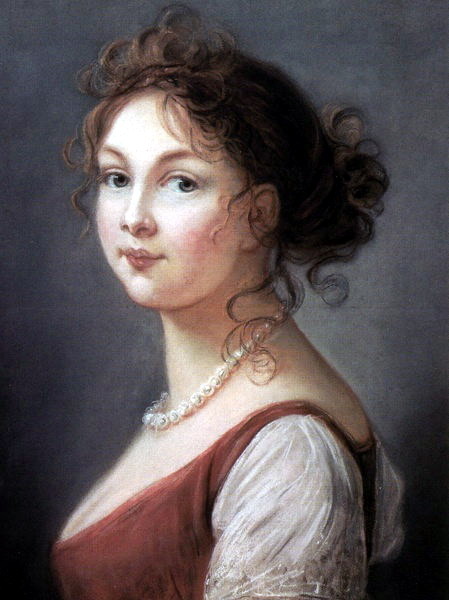
An Elisabeth Vigée-Lebrun painting of Queen Louise, c. 1801
The second source that mentions the relationship between these two is the book by Marian Brandys "Kozietulski i inni", which states (without giving sources, unfortunately) that during Pepi's visit to the capital of Prussia "… it was also said that the beautiful Queen Louise fell in love with in a knightly Pole."
However, if you ask my opinion about the likelihood of an affair between Pepi and the Queen of Prussia, I will say that in my opinion he was "flirting" her to make it easier to solve the inheritance problem. As for the fact that she could also be in love with the prince, I have no opinion because my knowledge about Queen Louise is not very great.
The second lady in today's list will be prince Józef's first cousin once removed, Anetka Potocka (née Tyszkiewicz, the daughter of Konstancja Poniatowska and a grand-daughter of prince Kazimierz, the oldest of the Poniatowski siblings).
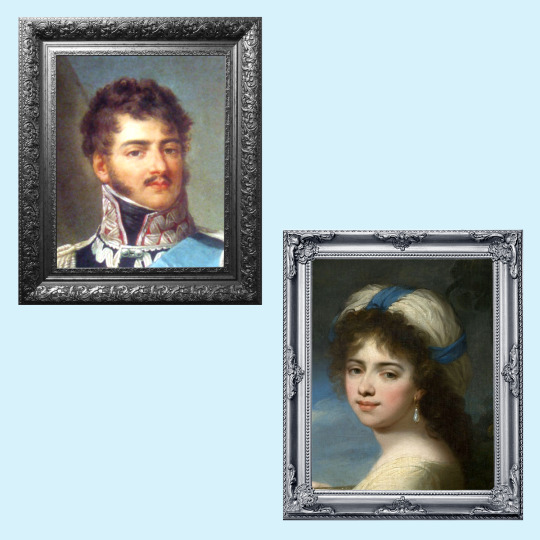
On the left - Poniatowski's portrait by Franciszek Paderewski, on the right - Portrait of Anetka Tyszkiewiczówna, Giuseppe Grassi, 1796.
Born in 1779, she was 16 years younger than Pepi, and she remained unmarried for quite a long time, becoming the wife of the Count Aleksander Potocki in 1805. (Marian Brandys, in the biography of Anetka's uncle prince Stanisław, states that some time before 1791 there was an idea to join all the Poniatowski estates marring Stanisław to his niece, but it was eventually abandoned.) The marriage brought them three children, but after 16 years Anetka asked for divorce and then wedded Colonel Stanisław Dunin-Wąsowicz. During the times of the Duchy of Warsaw, she was a frequent guest at the Copper Roof Palace, visited Paris, witnessed Napoleon's sojourns in Warsaw, with all of those events been described later in her memoirs.
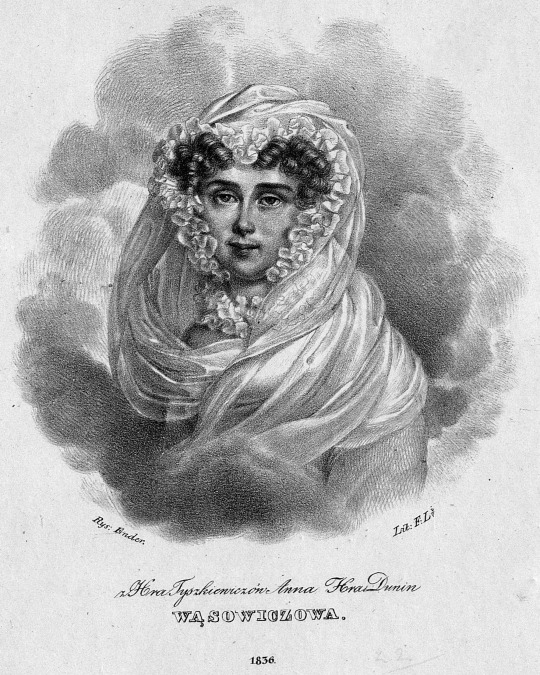
Portrait of Countess Dunin Wąsowicz, Anna née Tyszkiewicz, 1836.
As for her relationship with Prince Józef, it were her own words that made Fałkowski write that "the beautiful prince fell in love with Anetka" although "it was a platonic feeling".
"… Mrs. Aleksandrowa (Anetka Potocka - AS ) herself half-admitted thisin her old age. ''On disait alors que le Prince Joseph avait pour moi un sentiment plus tendre que l'amitié (it was said that Prince Joseph had for me a feeling more tender than friendship),' she would recalled with a dreamy expression on her face."
The second thing that leads historians to believe that Pepi could have distinguished this cousin of his from other relatives is the provision in his will, according to which she was to receive, after the death of the prince's sister, Teresa Tyszkiewicz, his favorite palace in Jabłonna near Warsaw. And when this did happen, Anetka ordered a triumphal arch to be built in the park in memory of Prince Józef.

The palace in Jabłonna, 2019
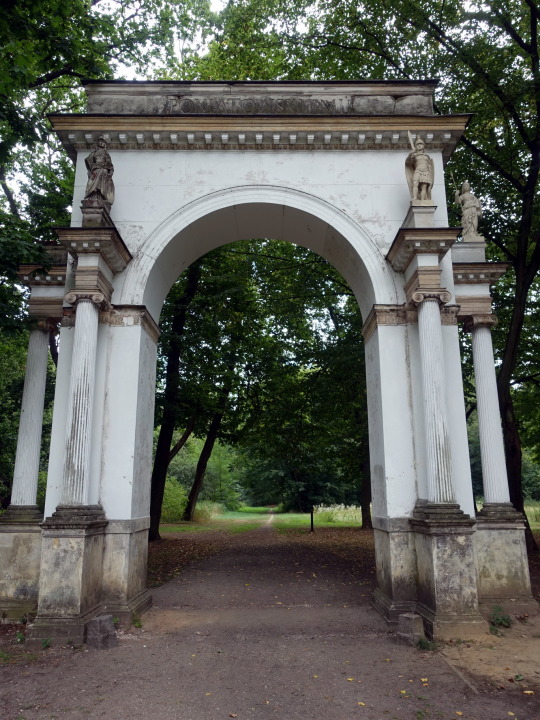
The triumphal arch from Jabłonna's park, 2019
And collage of mine is an illustration to the part dedicated to the rest of the women, whose portraits I wasn't able find. And honestly, the evidence that they might have been Prince Józef's love interests is very weak. But, since historians from time to time do mention these ladies' names, I thought them worth being included as well…
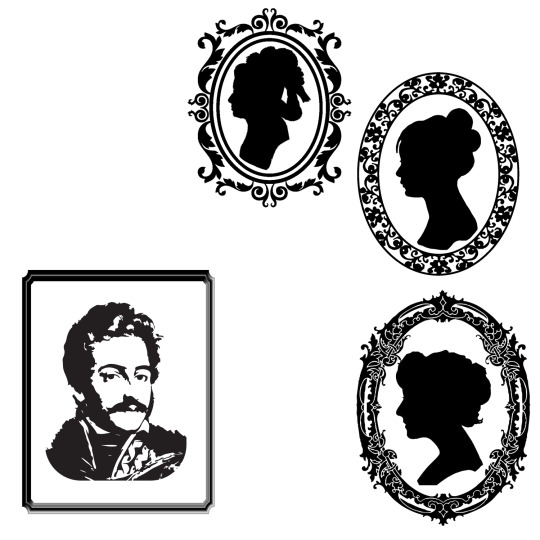
For example, in the prince's testament, together with Henriette de Vauban, Zofia Czosnowska and the above mentioned Anetka Potocka, there was mentioned Elżbieta Merlini, the daughter of Dominique Merlini, an Italian architect, the last main builder of the Polish-Lithuanian Commonwealth. But such concern for the architect's daughter may have been explained by a sense of moral debt to her father, which the prince Józef inherited from King Stanisław with the rest of the things.
Then, the list of Pepi's women sometimes complemented by another "Elżbieta" - Cichocka (although her real names were Emilia Karolina - or Katarzyna) née Bachmińska I° voto Szymanowska, II° voto Cichocka, III° voto Abramowiczowa. It is said she even sojourned in Jabłonna before 1810, until being apparently forced by Zofia Czosnowska to leave the place. After that Madame Cichocka went to Vilna, where she married her third husband. However, what IMHO should be taken into account in regards with this lady is that her second husband, Michał Cichocki, was an illegitimate son of Stanisław August, which might have made Prince Józef consider her a relative and thus take care about.
The same can be said about Madame Kicka - Józefa Martyna Rozalia née Szydłowska, who was a sister of Elżbieta Grabowska, another mistress of King Stanisław.
Sometimes the names of women who were friends and companions of Madame de Vauban are also included to the list of prince Józef's love interests. Those are: Anna Krasińska, a relative of general Krasiński and the wife of Mikołaj Oppeln-Bronikowski; Salomea Wielhorska née Dembińska; Anna Trębicka née Czerska, future wife of general Kamieniecki, and Józefa Potocka née Sollohub.
PS. As the regular visitors to the Copper Roof Palace are as well mentioned two ladies of the surname Walewska: Józefina née Lubomirska, the wife of Adam Walewski and the future wife General Witt, and Maria, the wife of Anastazy Walewski. The first of them was known for her kind of loose behavior, so presumably she might have at least flirted with Pepi; the second one is the famous Maria Walewska, but all I know about her makes me think her love for the emperor left no room in her heart for other men.
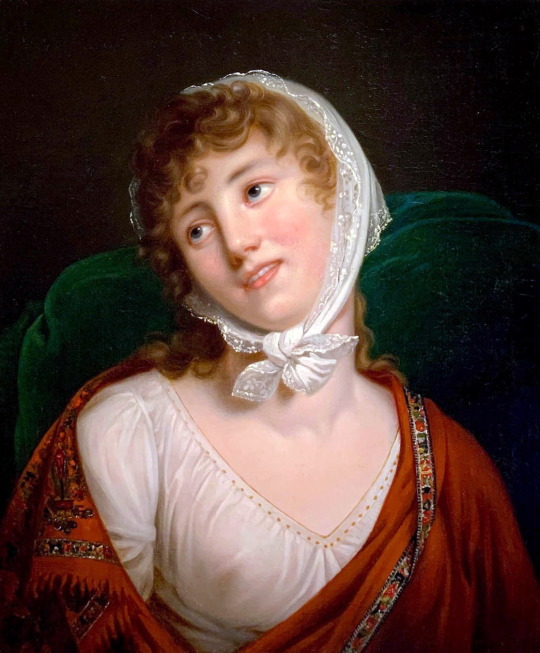
Portrait of Maria Walewska by Robert Lefèvre
#poniatowski#józef poniatowski#józef poniatowski’s women#queen Louise of Prussia#Giuseppe Grassi#Anetka Potocka#Jabłonna#Jabłonna palace#Maria Walewska#Robert Lefèvre
14 notes
·
View notes
Text
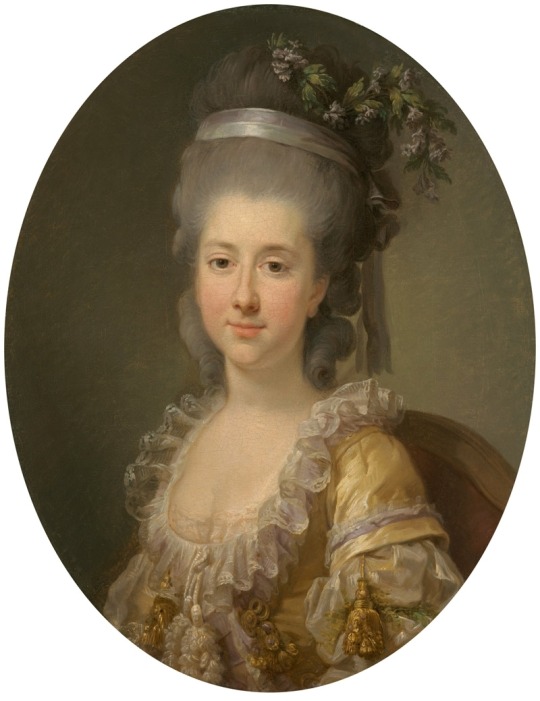
"Countess Potocka" by Élisabeth Vigée-Le Brun.
1 note
·
View note
Link
#AlessandroStradella#AngelaGheorghiu#ArthurRubenstein#CarnegieHall#FredericChopin#MusicReview#NewYorkPhilharmonic#PianoConcerto
0 notes
Photo
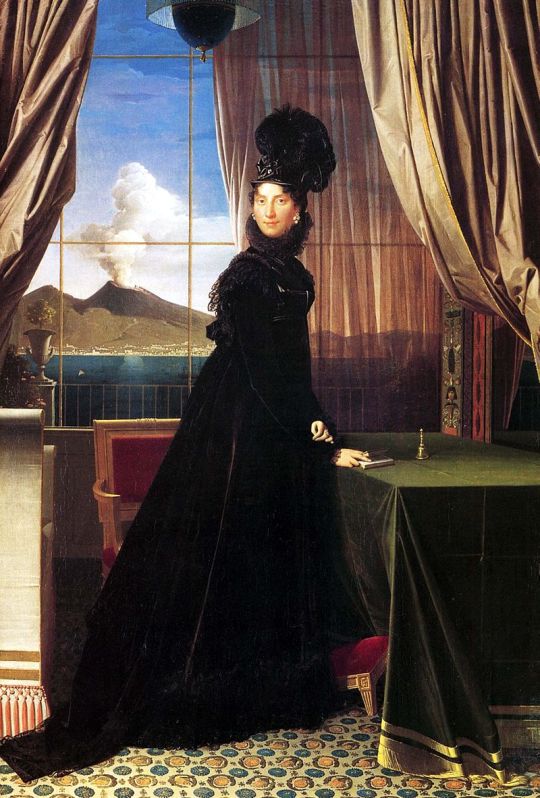
(Ingres, Caroline Murat, 1814) ~
Countess Anna Potocka, the same lady who one day in the summer heat had been dragged by the Davouts through their garden wilderness in order to feed some d...ed partridges, a decade after Napoleon’s fall made a trip to Italy. In a much more civilised manner, I presume. Among other towns, she also visited Triest. (Taken from a publication called »Voyage d’Italie«)
Trieste can only be of interest to those who, like us, have seen some personality there, for the city does not offer much attraction. We met Caroline, one of Napoleon's sisters.
In 1826 she lived in a pretty country house close to the town. This charming villa was called Campo Mars; the queen had bought it from a merchant in Trieste and had arranged it with infinite taste. The care and activity she put into managing the work on this little property seemed to have made her forget that she had once possessed the most beautiful of kingdoms. An alley planted with vines - in the Italian style - led to a small arbour overlooking the sea and the busy road; this is where we spent the evening hours, so beautiful under the Italian sky; it was there that I heard the anecdotes I am going to tell.
The house, of impeccable architecture, contained, apart from the elegant flat of the queen, a large salon devoted to souvenirs. A magnificent portrait of Murat on horseback was the principal ornament; Caroline never presented this salon, where the portraits of the whole family, marble busts or paintings, were gathered. The general (Macdonald) alone did the honours.
[...]
I had seen the Queen of Naples in Paris at the time of Napoleon's marriage to Marie-Louise; she had given me the impression of a pretty woman on the throne. I found her with a figure that was still pleasant, as it had been in the past. One could feel that she needed to make herself loved by all those who came near her. The throne had disappeared, but the charm had remained, contrasting in a piquant way with an uncommon strength of soul, a serious spirit, a kindness, an equality of mood, which such great misfortunes had not been able to embitter or even disturb.
The countess also muses a bit about the relationship between Caroline and general Macdonald (Are they a couple now? Had they been? - Not that it’s important, really, but …), admires how perfectly Caroline imitated Marie-Louise’s Austrian accent and in passing relates some childhood anecdotes of Napoleon – which are doubtful mostly because by the time Caroline was born Napoleon and Joseph were already living in France. So how would Caroline be able to tell?
She later in her journey visits Naples and is astonished about Caroline’s rooms in the palace of Portici:
On visiting this royal residence, I expected to find there the rare combination in Italy of magnificence and taste. It seemed to me that Queen Murat, accustomed to the splendour of the Tuileries, would have been able to reproduce the palace of Armide, of which, better than any other, she was worthy of being the deity.
Caroline's appartment, still intact, did not meet my expectations. It was that of a duchess of the Faubourg Saint-Germain. Apart from a few mosaic parquet floors, there were no riches other than Lyon fabrics. A few genre paintings by the French School, a lot of Sèvres porcelain, and a number of bronzes of rather poor taste were the main ornament of this residence.
Madame la contesse is hard to please, as usual. At least she didn’t have to feed any birds this time around.
The book also contains three letters by Caroline to countess Potocka, mostly related to the marriage of countess Potocka’s daughter.
25 notes
·
View notes
Text
Countess Potocka Visits the Davouts
The moment is drawing near when I will say goodbye to Countess Potocka. In my next post she will share the scene with another memoir-writer, both of them describing the same person in quite contrasting ways. For now, the Countess is still starring on her own, compelled by good manners to accept an invitation to a meal she would have given her left arm to be able to refuse. Marie-Louise being absent, the Countess finds another handy target for her barbs.
The Countess, having ascertained whether her visit will be more convenient in the daytime or in the evening (daytime), gets dressed in new, fashionable and expensive attire, though she is much bothered by her shoes (too small?). I can't help but think that this outfit was meant to impress the Davouts with her superior status and unimpeachable pedigree - something simpler would have been preferable, as we shall see. Since it's already three in the afternoon when she appears at her hosts' door, maybe they were not expecting her anymore, even if we assume she had advised them this was the day of her visit. At least the Countess is honest enough to state Madame Davout had treated her well in the past.
C'est ainsi que j'allai chez la maréchale Davout, qui m'avait comblée de prévenances pendant son séjour à Varsovie, du temps où son mari commandait en Pologne. Comme elle passait les étés à Savigny (1), c'est là qu'il fallut aller la chercher. J'envoyai à son hôtel en ville quelle serait l'heure la plus convenable pour faire ma visite, - on me répondit que ce serait dans la matinée. Je me rendis donc à Savigny par un soleil brûlant, mal garantie par un très petit chapeau orné de violettes, et très gênée dans mes brodequins lilas parfaitement assortis à une robe montante en gros de Naples de même couleur ; - madame Germont, oracle de la mode, avait elle-même combiné toute ma toilette.
[...]
[J]e me promettais une visite agréable. L'hôtel de la maréchale, à Paris, m'avait donné une grande idée de son goût et de son opulence, et je pensais la trouver luxueusement établie à Savigny. J'arrivai vers trois heures. Le château, entouré d'un fossé et d'un mur, avait pour entrée une porte hermétiquement fermée. L'herbe croissait dans les fossés ; - on eût dit une habitation abandonnée depuis maintes années. Mon laquais, ayant enfin trouvé le cordon de la sonnette, une petite fille assez mal vêtue vint, au bout de quelques minutes, demander ce qu'on désirait.
- Madame la maréchale est-elle à la maison?
- Oh ! pardonnez-moi, qu'ils y sont, et M. le maréchal aussi, répondit la fillette.
Et vite elle accourut appeler un des hommes du château, qui se mit à la suivre sans se presser et tout en ajustant sa livrée.
Je me fis annoncer, et blottie dans la voiture, j'attendis encore assez longtemps, ne sachant trop si je devais insister ou simplement laisser une carte.
Au bout d'un petit quart d'heure un valet de chambre se présenta enfin à la portière du carrosse et me fit entrer dans une vaste cour ; il s'excusa des lenteurs du service, m'avouant sans façons qu'à l'instant où j'étais arrivée, les gens travaillaient au jardin, et que lui-même était occupé à nettoyer le verger.
On me fit traverser plusieurs salons complètement démeublés ; la pièce où l'on m'introduisit n'était guère plus ornée que les précédentes, mais au moins il y avait un canapé et des chaises ! La maréchale ne tarda pas à apparaître. Je m'aperçus aisément qu'elle avait fait toilette pour moi, car elle attachait encore quelques épingles à son corsage. Après quelques minutes d'une conversation languissante, elle sonna pour faire prévenir son mari. Puis nous reprîmes notre entretien pénible. Ce n'est pas que madame Davout manquât d'usage ou fût dépourvue de cette sorte d'esprit qui facilite les rapports entre deux personnes du même monde, mais il y avait en elle une certaine roideur qui pouvait être prise pour de la morgue. Elle ne perdait jamais de vue le maréchalat ; jamais un sourire gracieux ne venait animer les traits de sa beauté sévère. [...]
Le maréchal arriva enfin dans un état de transpiration qui attestait son empressement ; il s'assit tout essoufflé, et, tenant son mouchoir de poche pour s'essuyer le front, il eut soin de le mouiller de salive afin d'enlever plus sûrement la poussière dont sa figure était couverte. Cet abandon un peu soldatesque cadrait mal avec les manières empesées de son épouse ; elle en fut visiblement contrariée. Me trouvant de trop dans cette scène muette, je me levai et voulus prendre congé, mais on me pria de rester à déjeuner. En attendant que le repas fût servi, nous fîmes une promenade dans le parc... Il n'y avait aucun chemin tracé, les gazons étaient de hautes herbes toutes prêtes à devenir des meules de foin, les arbres coupés pendant la Révolution repoussaient en manière de broussaille ; je laissais à chaque buisson des fragments de mes volants, et mes brodequins lilas avaient pris une teinte verdâtre. Le maréchal nous encourageait de la voix et du geste, nous promettant une surprise charmante !... Quel ne fut pas mon désappointement lorsque, au détour d'un massif de chênes adolescents, nous nous trouvâmes en face de trois petites huttes en osier ! Le duc mit un genou en terre et s'écria :
- Ah! les voilà... les voilà !...
Puis, modulant sa voix :
- Pi... pi... pi...
Aussitôt une nuée de perdreaux se mit à voltiger autour de la tête du maréchal.
- Ne laissez sortir les autres qu'au moment où les plus jeunes seront rentrés, et donnez du pain à ces dames... Elles vont s'amuser comme des reines, dit-il à un rustre qui remplissait les fonctions de garde-chasse.
Et nous voilà, par un soleil brûlant, donnant la becquée aux perdreaux !
La duchesse vida, avec un calme et une dignité imperturbable, le panier qu'on lui avait présenté. Quant à moi, je faillis me trouver mal, et, n'y tenant plus, je fis observer que le ciel se couvrait et que nous étions menacés d'un orage.
[...]
Le déjeuner fini, je m'esquivai en toute hâte, jurant, mais un peu tard, qu'on ne m'y prendrait plus.
Thus I went to the home of Maréchale Davout, who had showered me with courtesies during her stay in Warsaw, when her husband was in command in Poland. As she spent the summers in Savigny (1), it is there that I had to go and find her. I wrote to her Paris house to find out the most convenient time to visit her, and was told that it would be in the daytime. So I went to Savigny on a broiling hot day, little protected from the sun by a very small hat adorned with violets, and very uncomfortable in my lilac booties perfectly matched with a high dress in taffeta in the same color; - Madame Germont, the oracle of fashion, had herself arranged my costume.
[...]
I had promised myself this would be a pleasant visit. The Maréchale's Paris residence had much impressed me with her taste and love of fashion, and I thought I would find her luxuriously settled in Savigny. I arrived at about three o'clock. The door of the chateau, which was encircled by a moat and an enclosure, was hermetically sealed. Tall grasses were growing in the moat; the chateau had the appearance of having been deserted for many years. My footman having finally found the doorbell, a little girl, rather ill-dressed, appeared, after a few minutes, to ask what was wanted.
- "Is Madame la Maréchale at home?"
- "Oh, but yes, they are there, and so is the Marshal," answered the little girl.
And she hurried to summon one of the servants of the chateau, who proceeded to follow her at a leisurely pace, adjusting his livery as he went.
I had myself announced, and huddling in the carriage, I waited for quite a while, wondering whether I should insist or whether I ought to simply leave a visiting card.
After a mere quarter of an hour, a manservant finally appeared at the door of my carriage and led me into a vast courtyard; he apologized for the slowness of the service, informing me without particular deference that at the moment I arrived, the household staff was working in the garden, and that he himself had been engaged in tidying the orchard.
I was led through several completely unfurnished salons; the room into which I was ushered was hardly more ornate than the previous ones, but at least it had a sofa and chairs! The Maréchale presently appeared. I could easily perceive that she had just dressed up for me, because she was still busy fastening some pins to her bodice. After a few minutes of languishing conversation, she pulled the bellcord so her husband could be apprised of my presence. She and I then resumed our awkward conversation. It is not that Madame Davout's manners were lacking, or that she was deprived of that sort of wit which facilitates exchages between people of similar backgrounds, but there was in her manner a kind of stiffness which might be mistaken for arrogance. She never forgot about the marshalate; never did a gracious smile enliven the features of her austerely beautiful face. [...]
The Marshal finally arrived, his haste reflected in his heavy perspiration; out of breath, he sat down and, using his pocket handkerchief to wipe his forehead, he moistened it with saliva in order to more efficiently remove the dust from his face. This casualness, a bit too soldierly, contrasted sharply with the starchy demeanor of his wife; she was noticeably annoyed about it. Finding myself de trop in this silent scene, I rose and tried to take my leave, but I was enjoined to stay for a mid-day meal. While waiting for this to be served, we went a walk in the grounds... There were no paths, the lawn was covered with high grass ready to be turned into haystacks, the trees, cut down during the Revolution, were growing back as scrub; I left shreds of my dress's ruffles on each bush, and my lilac booties had taken on a greenish tinge. The Marshal encouraged us by voice and by gesture with the promise of a charming surprise!... What disappointment when, at the bend of a clump of stripling oaks, we finally stood in front of three small wicker huts! The Duke went down on one knee and exclaimed:
- "Ah! here they are... here they are!..."
Then, modulating his voice:
- "Pi... pi... pi..."
And at once a swarm of partridges began to flutter around the Marshal’s head.
- "Don't let the others go out until the youngest have returned, and give the ladies some bread... They are going to enjoy themselves like queens", he said to a roughneck who was the gamekeeper.
And there we were, under scorching sunshine, feeding partridges!
With unruffled and imperturbable dignity, the Duchess emptied the basket of bread she had been given. I, on the other hand, came close to fainting, and this being beyond my endurance, I pointed out that clouds were moving in and that a storm threatened.
[...]
Once we had finished eating, I left in greatest haste, swearing to myself that this visit would not be repeated.
(1) Savigny-sur-Orge [this note appears in the original text]
https://gallica.bnf.fr/ark:/12148/bpt6k5463019n/f278.item pp. 229-234.
So there went the Countess’s pleasant visit, just not quite as pleasant as foreseen. I confess that I share her feelings about the spit-moistened handkerchief. And I too have been in the excruciating position of trying to make conversation when there is nothing to converse about. But she did not expect to have her fancy dress shredded by unkempt scrub. All this while traipsing in uncomfortable booties ruined by grass stains, the reward for this being to witness Davout calling his partridges in a falsetto voice, and a final indignity, bringing her close to fainting (or was it the foot-pinching booties?): having to feed breadcrumbs to partridges, while being expected to have fun doing it. Pass the smelling salts.
The food must have been good, because she does not have a word of criticism about it. No word whatsoever about it, in fact. I suppose no artichokes were served.
My little finger tells me the Davouts were not sorry to see the back of her, unless her manners were so exquisite that she was able to feign delight through her visit. But then again there was this laboured conversation, so... no. They were glad she left.
44 notes
·
View notes
Text
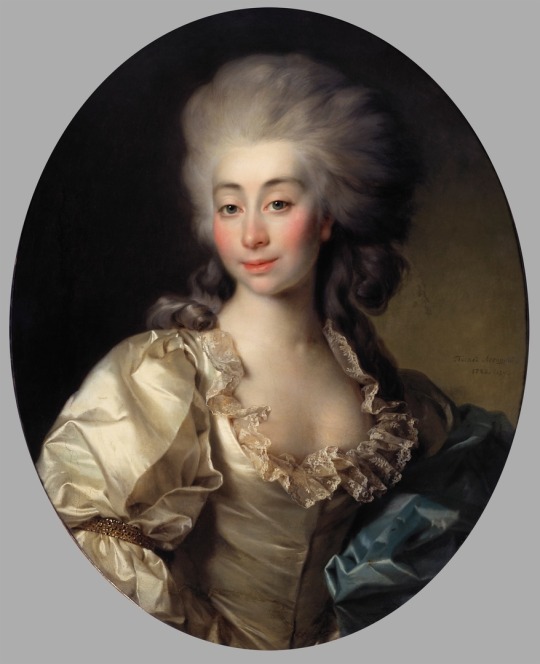
"I had another aunt in Paris, Countess Mniszech, cousingerman to my mother, and a niece of our last king. She took up a great deal of my time. A good soul, but rather stupid and absurdly vain, she believed herself entitled to the prerogatives of princesses of the blood, and in this connection she had many unpleasant experiences. Neither the sad end of the last Polish king nor the dismemberment of our unhappy country had been able to cure her pretentiousness. The Empress of Russia, at the period when she lavished honours upon the Poles, had sent her the order of Saint Catherine. My aunt exhibited the medal on all great occasions, to such good effect that in Vienna she had been nicknamed Countess Medal. She was not in the least aware of how ridiculous she made herself. All she thought of was to uphold the dignity of her name by display. In Paris she had in her service the house steward of the unfortunate".
Memoirs of the Countess Potocka
2 notes
·
View notes
Note
Who is this General Macdonald who was at Caroline's court? He certainly was not the Marshal, but does not appear in Wikipedia's list of generals who served France during the Revolution and the Empire. Was there an Italian branch of the MacDonalds who emigrated after 1745?
Details on him are sparse. He was not a marshal, or, as far as I’m aware, any relation to the French marshal of the same name. Francesco Macdonald was born in either 1776 or 1777 (I’ve seen both years given) in Pescara. He attended the Nunziatella Military School as a child and took part in the siege of Toulon as a soldier in the army of King Ferdinand of Naples when he was only 16 years old. But after Napoleon’s Italian campaign, he crosses over into the French army; after Ferdinand is driven out of Naples, he will serve under Masséna. He eventually becomes one of Murat’s most loyal generals in Naples and, in 1814, is made his minister of war. He remains loyal to Murat even after his defeat at Tolentino (when many of Murat’s other generals began abandoning ship), and accompanies Caroline Murat and her children to Trieste, where he joins them in exile.
Allegedly he and Caroline married at some point, but it is impossible to be certain of the year. Napoleon first reads reports of their marriage in Vienna in a newspaper in 1817; the news sends him into a rage (Gourgaud attributes this news being the cause of the Emperor’s sour mood for some time afterwards). But I’ve also seen 1830 attributed as the date of their marriage. The historian Jean Tulard seems to think 1817 is the more credible version, but who knows. It seems to have been primarily a marriage of expediency; Macdonald went to France on a number of occasions to advocate on Caroline’s behalf to try to have Murat’s former properties in France restored to her (or to at least be compensated for them). They had no children together. Macdonald died in 1837 in Florence, two years before Caroline.
There are a couple of recollections I’ve come across of Macdonald and his relationship with Caroline during the exile, as observed by Juliette Récamier and Countess Potocka, both of whom visited Caroline during their travels in the 1820s.
Mme Récamier writes of Macdonald that he
had been aide-de-camp to King Joachim, and Minister during the regency of Queen Caroline. He had never left the widow and children of his old master, and was now their only friend and courtier in adversity. The queen, whose skin was as fair as a lily, was still singularly pretty, almost retaining the brilliancy of her youth. She had grown stout; and, as she was not tall, her figure had not gained in elegance. She was animated in conversation ; and, from her caressing manners, it was easy to see, that, when she wished to please, she could exercise great powers of fascination. Her intercourse with her daughter was full of the most confiding tenderness. Her bearing to General Macdonald was affectionate, with a shade of authority.
(Jeanne Françoise Julie Adélaïde Bernard Récamier, Memoirs and correspondence of Madame Récamier, Boston, 1867, pages 240-241.)
Countess Potocka writes that
A loyal friend remained. The qualities of this man, like his attachment, were superior; the elevation of his soul was reflected on his noble face. An infinite sweetness was found in exploring the character of a man whose existence was composed, so to speak, of devotion and delicate feelings. Such was General Macdonald, who was said to be secretly married to the Queen.
During the six weeks that I saw them daily, I perceived nothing which could make me adopt or reject this idea; on one part, the most frank friendship and well-founded esteem; on the other, the most sustained respect and the most complete abnegation. Such were the relations that existed between them. It is probable that love had passed by them, and what remained did honor to them both.
(Countess Potocka, Voyage d’Italie (1826-1827), 1899 edition, pages 5-13.)
Macdonald was something of an amateur artist. Here is a painting he did of Caroline with a servant in 1825:
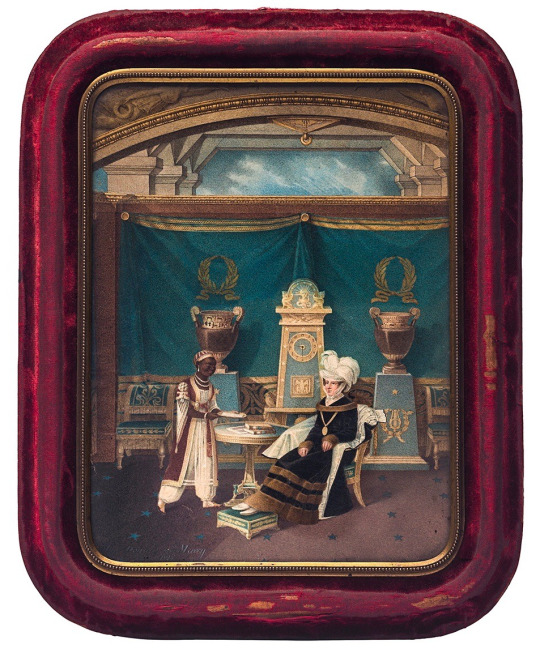
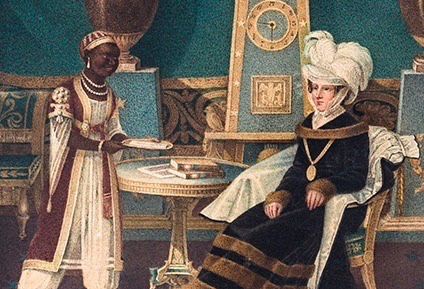
I believe he also made drawings/paintings of the Murat children, but I can’t recall having seen them. If I find any of them I’ll post them.
#Francesco Macdonald#Caroline Murat#Caroline Bonaparte#Juliette Récamier#Countess Potocka#memoirs#asks
21 notes
·
View notes
Photo
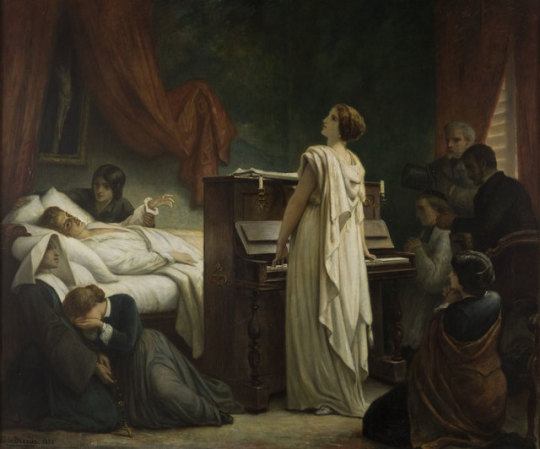
Death of Chopin (1885). Felix-Joseph Barrias (French, 1822-1907). Oil on canvas. Krakow National Museum.
Barrias may have used the description of Chopin's last moments which was noted for posterity by Solange, the daughter of George Sand and the wife of the sculptor Clésinger: “One October evening in 1849, the 16th, approximately twenty people were fearfully waiting in the living room (...) Chopin had someone ask whether Countess Potocka was also in the living room, and if she would sing. The piano was moved closer, the doors were opened, and the beautiful Countess began to sing. She sang with a broken heart, a voice full of tears! The gathered guests fell on their knees, stifling a sob.”
300 notes
·
View notes
Photo
For those who read my Countess Potocka posts, this was her expression when she saw Davout feeding his partridges - and then had to do the same!

(by berelaxed)
135K notes
·
View notes
Text

Countess Katarzyna Potocka
2 notes
·
View notes
Text

Chopin Dying, Lionello Balestrieri (Italian, 1872-1958)
"The Polish Countess Potocka sings a psalm at his dying request".
#chopin art#chopin#delfina potocka#death of chopin#lionello balestrieri#chopin triptych#piano#classical music#dark academia#fryderyk chopin#frederic chopin#psalm#october#pianist#romantic academia#polish music#art#italian art#italian painter#piano music
198 notes
·
View notes
Text
Napoleon gets some bad news
(From the memoirs of Countess Potocka)
Along with the aristocracy of half of Europe, the Countess Potocka had come to Paris for Napoleon's wedding celebrations with Marie Louise. On June 28, 1810, she was invited to Napoleon's residence at Saint Cloud for an informal dinner: only she, Minister of the Interior Montalivet, Princess Borghese (Napoleon's sister Pauline), the Grand Duke of Würzburg (Marie Louise's uncle), and the imperial couple themselves. At the end of this (hurriedly consumed) dinner, an interruption occurred:
We were about to rise from the table when the chamberlain approached to inform the Emperor that the Viceroy of Italy was waiting for him in the garden. He rose hastily without giving Marie-Louise time to finish the ice-creams, which upset her so much that she could not resist complaining about it to her uncle.
When we returned to the salon, where the two ladies on duty had preceded us, we found the windows wide open; they overlooked the main avenue of the park.
Prince Eugene was walking there in great agitation; as soon as Napoleon saw him, he went to join him. Judging by the liveliness of their conversation, the subject had to be very serious. The Emperor was gesticulating, like a true Corsican; the Prince seemed to be trying to calm him down; it was easy to see that Napoleon was not happy. There were bursts of voices which reached us, but the wind carried away the words.
In the salon silence was interrupted only by a few banal phrases which M. de Montalivet considered himself bound to address to us, so as not to seem to be overhearing the conversation taking place in the garden.
The Empress did not utter a word; sitting beside her uncle, who gave her the example of the most perfect silence, she looked vaguely out of the window, without the least concern for what was going on in the park, where the increasingly animated conversation was still going on.
As everything becomes known, especially at court, where so many eyes and ears are open to see and hear everything, we soon learned what the cause of this storm had been.
The Viceroy, charged by his brother-in-law, the King of Holland, with the task of informing the Emperor of the fact that he wished to renounce the throne, had just accomplished this difficult mission, and had most probably endeavoured to excuse his brother-in-law.
If the countess is correct in assuming that this conversation was about Louis Bonaparte's impending abdication, I'm beginning to feel that the entire empire had come to a tacit agreement: Have a really shitty job that no one else wants to do? Call the Beauharnais boy! (Viceroy of Italy, marriage to unknown high noblewoman, pacify Tyrol, explain to the French Senate the expulsion of one's own mother, have Andreas Hofer shot, put a gun to the head of the Austrian ambassador so that he will hand over the emperor's daughter as a bride, tell my brother where he can stick his Dutch crown...).
Possibly this is what Murat finally came to realise when, freezing among the remains of the Grande Armée in January 1813, he reflected on his situation: "This is a really shitty job... Hold a second!"
Plus, yet another wonderful comedy scene, with Montalivet desperately trying to engage in small talk, while all the ladies can barely keep themselves from hanging their heads out of the window in order to listen in on what Napoleon and Eugène are talking about... That’s the funny stuff that they never put in the movies.
28 notes
·
View notes